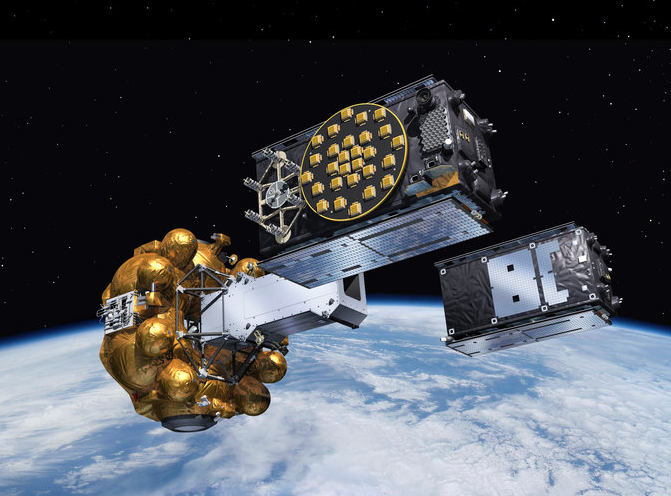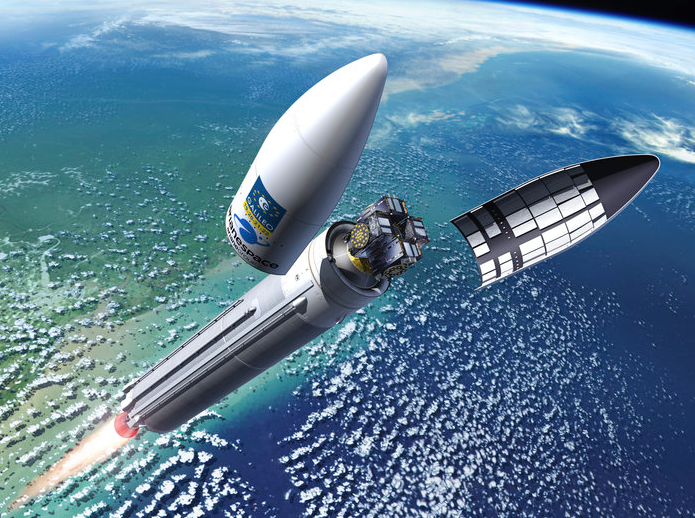
Four more Galileo satellites were launched by an Ariane 5 rocket, bringing the Galileo constellation to 26 satellites, extending the global coverage of the constellation. Paul Verhoef, ESA’s Director of Navigation, added, “Galileo has been providing Initial Services on a worldwide basis since December 15, 2016, and today has more than 100 million users, and rapidly increasing. Today’s satellites will increase the global coverage of Galileo with a performance that is widely recognized as excellent."

The Fregat upper stage flew the latest two Galileo satellites most of the way up to medium-Earth orbit before they finally separated.
Copyright ESA–Pierre Carril, 2014
Ariane 5 flight VA244 which is operated by Arianespace under contract to ESA, lifted off from Europe’s Spaceport in Kourou, French Guiana, at 11:25 GMT (13:25 CEST, 08:25 local time), carrying Galileo satellites 23–26. The first pair of 715 kg satellites was released almost 3 hours 36 minutes after liftoff, while the second pair separated 20 minutes later.
They were released into their target 22,922 km-altitude orbit by the dispenser atop the Ariane 5 upper stage. In the coming days, this quartet will be steered into their final working orbits by the French space agency CNES, under contract to the Galileo operator SpaceOpal for the European Global Navigation Satellite System Agency (GSA). There, they will begin around six months of tests by SpaceOpal to verify their operational readiness so they can join the working Galileo constellation.
Jan Wörner, ESA’s Director General said that Galileo is ESA’s largest ever satellite constellation, built up to its present size in rapid time, with 22 Full Operational Capability satellites added within just the last four years.
He continued that they must thank their industrial partners OHB (DE) and SSTL (GB) for the satellites, as well as Thales Alenia Space (FR/IT) and Airbus Defence and Space (GB/FR) for the ground segment and all their subcontractors throughout Europe for their continued support to the program. Together with ESA, the entire industrial team has worked hard for the point at which they now are and this cooperation have proven to be very successful, as they can show in the excellent performance of Galileo.

Artist's view of four Galileo satellites mounted on top of a specially adapted Ariane 5 rocket underneath the aerodynamic fairing.
ESA–Pierre Carril, 2017
Paul Verhoef, ESA’s Director of Navigation, added that Galileo has been providing Initial Services on a worldwide basis since December 15, 2016, and today has more than 100 million users, and rapidly increasing. Today’s satellites will increase the global coverage of Galileo with a performance that is widely recognized as excellent.
This is the end of the current phase of Galileo deployment, but their pace is not slacking. A further 12 Galileo ‘Batch 3’ satellites are in preparation as in-orbit spares and as replacements for the oldest Galileo satellites, first launched in 2011, in order to keep the system working seamlessly into the future. Then a new generation of Galileos are planned for the middle of the next decade, offering improved performance and added features, maintaining Galileo as a permanent feature of the global GNSS landscape. Galileo is Europe’s civil global satellite navigation system. Once complete, the system will consist of 24 operational satellites plus orbital spares, and the ground infrastructure for the provision of positioning, navigation and timing services. But the system is already available to users with recent receivers which combine the Galileo and GPS navigation messages for a more precise positioning.
The Galileo program is funded and owned by the EU. The European Commission has the overall responsibility for the program, managing and overseeing the implementation of all program activities.
ESA is entrusted with Galileo’s deployment, the design and development of the new generation of systems and the technical development of infrastructure. The definition, development and in-orbit validation phases were carried out by ESA, and co‑funded by ESA and the European Commission. GSA is ensuring the uptake and security of Galileo. Galileo operations and provision of services were entrusted to the GSA in July 2017.

